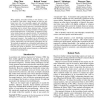Free Online Productivity Tools
i2Speak
i2Symbol
i2OCR
iTex2Img
iWeb2Print
iWeb2Shot
i2Type
iPdf2Split
iPdf2Merge
i2Bopomofo
i2Arabic
i2Style
i2Image
i2PDF
iLatex2Rtf
Sci2ools
95
Voted
FLAIRS
2008
2008
Semantic Analysis of Association Rules
When applying association mining to real datasets, a major obstacle is that often a huge number of rules are generated even with very reasonable support and confidence. Among these rules, many are trivial, redundant, semantically wrong, or already known by end-users. Association rule postprocessing aims to remove these undesired rules. Existing work mainly focuses on reducing redundant or finding unexpected association rules. In this paper, we propose an innovative method based on semantic network. We semantically divide association rules into five categories: trivial, known and correct, unknown and correct, known and incorrect, unknown and incorrect. Our method can be efficiently integrated with existing rule reduction techniques to construct a concise, high-quality, and user-specific association rule set. We evaluate our approach on a real public-health dataset, the Heartfelt study, and we can prune off 97.81% of association rules that are trivial or incorrect. The remaining rules a...
Artificial Intelligence | Association Rules | FLAIRS 2008 | Rule Postprocessing Aims | Unexpected Association Rules |
Related Content
| Added | 02 Oct 2010 |
| Updated | 02 Oct 2010 |
| Type | Conference |
| Year | 2008 |
| Where | FLAIRS |
| Authors | Ping Chen, Rakesh M. Verma, Janet C. Meininger, Wenyaw Chan |
Comments (0)

